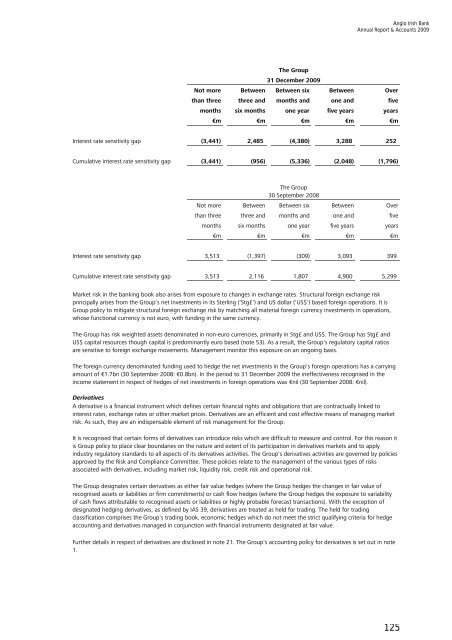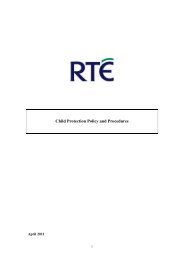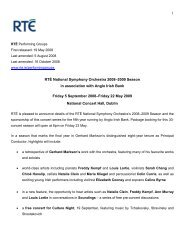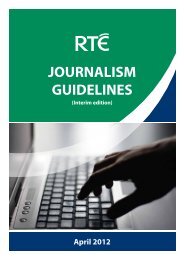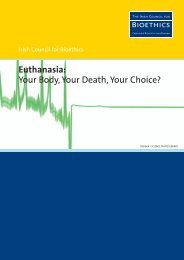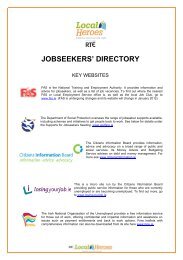Annual Report & Accounts 2009
Annual Report & Accounts 2009
Annual Report & Accounts 2009
You also want an ePaper? Increase the reach of your titles
YUMPU automatically turns print PDFs into web optimized ePapers that Google loves.
Anglo Irish Bank<br />
<strong>Annual</strong> <strong>Report</strong> & <strong>Accounts</strong> <strong>2009</strong><br />
The Group<br />
31 December <strong>2009</strong><br />
Not more Between Between six Between Over<br />
than three three and months and one and five<br />
months six months one year five years years<br />
€m €m €m €m €m<br />
Interest rate sensitivity gap<br />
(3,441) 2,485 (4,380) 3,288 252<br />
Cumulative interest rate sensitivity gap<br />
(3,441) (956) (5,336) (2,048) (1,796)<br />
The Group<br />
30 September 2008<br />
Not more Between Between six Between Over<br />
than three three and months and one and five<br />
months six months one year five years years<br />
€m €m €m €m €m<br />
Interest rate sensitivity gap<br />
3,513 (1,397) (309) 3,093 399<br />
Cumulative interest rate sensitivity gap<br />
3,513 2,116 1,807 4,900 5,299<br />
Market risk in the banking book also arises from exposure to changes in exchange rates. Structural foreign exchange risk<br />
principally arises from the Group’s net investments in its Sterling ('Stg£') and US dollar ('US$') based foreign operations. It is<br />
Group policy to mitigate structural foreign exchange risk by matching all material foreign currency investments in operations,<br />
whose functional currency is not euro, with funding in the same currency.<br />
The Group has risk weighted assets denominated in non-euro currencies, primarily in Stg£ and US$. The Group has Stg£ and<br />
US$ capital resources though capital is predominantly euro based (note 53). As a result, the Group's regulatory capital ratios<br />
are sensitive to foreign exchange movements. Management monitor this exposure on an ongoing basis.<br />
The foreign currency denominated funding used to hedge the net investments in the Group's foreign operations has a carrying<br />
amount of €1.7bn (30 September 2008: €0.8bn). In the period to 31 December <strong>2009</strong> the ineffectiveness recognised in the<br />
income statement in respect of hedges of net investments in foreign operations was €nil (30 September 2008: €nil).<br />
Derivatives<br />
A derivative is a financial instrument which defines certain financial rights and obligations that are contractually linked to<br />
interest rates, exchange rates or other market prices. Derivatives are an efficient and cost effective means of managing market<br />
risk. As such, they are an indispensable element of risk management for the Group.<br />
It is recognised that certain forms of derivatives can introduce risks which are difficult to measure and control. For this reason it<br />
is Group policy to place clear boundaries on the nature and extent of its participation in derivatives markets and to apply<br />
industry regulatory standards to all aspects of its derivatives activities. The Group's derivatives activities are governed by policies<br />
approved by the Risk and Compliance Committee. These policies relate to the management of the various types of risks<br />
associated with derivatives, including market risk, liquidity risk, credit risk and operational risk.<br />
The Group designates certain derivatives as either fair value hedges (where the Group hedges the changes in fair value of<br />
recognised assets or liabilities or firm commitments) or cash flow hedges (where the Group hedges the exposure to variability<br />
of cash flows attributable to recognised assets or liabilities or highly probable forecast transactions). With the exception of<br />
designated hedging derivatives, as defined by IAS 39, derivatives are treated as held for trading. The held for trading<br />
classification comprises the Group's trading book, economic hedges which do not meet the strict qualifying criteria for hedge<br />
accounting and derivatives managed in conjunction with financial instruments designated at fair value.<br />
Further details in respect of derivatives are disclosed in note 21. The Group's accounting policy for derivatives is set out in note<br />
1.<br />
125


